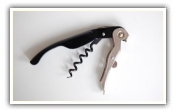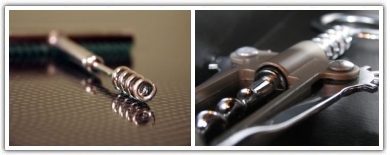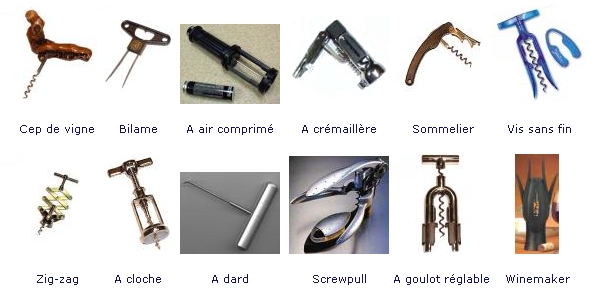Corkscrews

Introduction
A corkscrew is a tool for drawing stopping corks from wine bottles. Generally, it consists of a pointed metallic helix (often called the "worm") attached to a handle. The user grips the handle and screws the metal point through the cork, entwining the cork and corkscrew so that moving one moves the other. Corkscrews are necessary because corks themselves, being small and smooth, are difficult to grip and remove, particularly when inserted fully into an inflexible glass bottle. The handle of the corkscrew, often a horizontal bar of wood attached to the screw, allows for a commanding grip to ease removal of the stopper. Corkscrew handles may incorporate levers that further increase the amount of force that can be applied outwards upon the cork.

History
Its design may have derived from the gun worm which was a device used by musketmen to remove unspent charges from a
musket's barrel in a similar fashion, from at least the early 1630s.
The corkscrew is possibly an English invention, due to the tradition of beer and cider, and Treatise on Cider by
John Worlidge in 1676 describes "binning of tightly corked cider bottles on their sides", although the earliest
reference to a corkscrew is, "steel worm used for the drawing of Corks out of Bottles" from 1681.
In 1795, the first corkscrew patent was granted to the Reverend Samuell Henshall, in England. The clergyman affixed
a simple disk, now known as the Henshall Button, between the worm and the shank. The disk prevents the worm from
going too deep into the cork, forces the cork to turn with the turning of the crosspiece, and thus breaks the
adhesion between the cork and the neck of the bottle. The disk is designed and manufactured slightly concave on the
underside, which compresses the top of the cork and helps keep it from breaking apart.
Types

Wing corkscrew
A wing corkscrew, sometimes called a butterfly corkscrew or angel corkscrew, has two levers, one on either side of the worm. As the worm is twisted into the cork, the levers are raised. Pushing down the levers draws the cork from the bottle in one smooth motion. The most common design has a rack and pinion connecting the levers to the body. The head of the central shaft is frequently modified to form a bottle opener, increasing the utility of the device. Corkscrews of this design are particularly popular in household use.
Sommelier knife
A sommelier knife or waiter's friend is a corkscrew in a folding body similar to a pocket knife. It was conceived
by the German Karl Wienke in 1882 and patented in Germany, England, and America.
An arm extends to brace against the lip of the bottle for leverage when removing the cork. Some sommelier knives
have two steps on the lever, and often also a bottle opener. A small hinged knife blade is housed in the handle end
for removing the foil wrapping the neck of many wine bottles.
Twin prong cork puller
Also known as a butler's friend, the twin-prong cork puller can also be used to put the cork back into the bottle, thus allowing to sample the wine without damaging the cork. To remove the stopper, the prongs are pushed in between the cork and the neck of the bottle, and the cork can then be twisted out of the bottle. Replacing the stopper involves taking it between the two prongs, then twisting it into the bottle and pulling out the prongs.
Famous manufacturers
- Armstrong
- Cope & Cutler
- A. P. Debouchoir, French
- Dowler
- Dunisch & Scholer, German
- Farrow & Jackson
- Griffon Cutler Works, German
- John & Robt Harvey & Co Ld, Glasgow
- James Heeley & Sons
- G. F. Hipkins & Sons
- Carl Hollweg, German
- Edmund Jansen
- Theodor Kampf, German
- Korkmaster, American
- Leboullanger
- Arthur Lehmann & Co, Peoria, Illinois
- W. R. Loftus, 321 Oxford St William Lund Cornhill and Fleet St, London
- Mercier & Co, French
- Monopol, German
- Lucien Mumford, American
- W. Neues, German
- Noyles
- Sanbri, French
- Sommer, German
- Stephen Plant
- Sturo, Italian
- Syracuse Ornamental Company (Syroco) of Syracuse, New York
- Sir Edward Thomason
- Vaughan, American
- Vogliotti, Italian
- Williamson, American
- Wingfield & Co, Sheffield
- Johan Wolters, German
Corkscrew collections
In August 2006 the University of California, Berkeley displayed a 1,500-item corkscrew collection at the Phoebe A.
Hearst Museum of Anthropology in Kroeber Hall, on the UC campus.
Since July 2006, the Montecalvo Versiggia near Pavia, Italy is displaying a collection of over 200 different types of corkscrews.
The Greystone campus of the Culinary Institute of America has over 500 corkscrews on display in Saint Helena, California.



 Regions of France
Regions of France Regions of Spain
Regions of Spain Regions and areas from the world
Regions and areas from the world